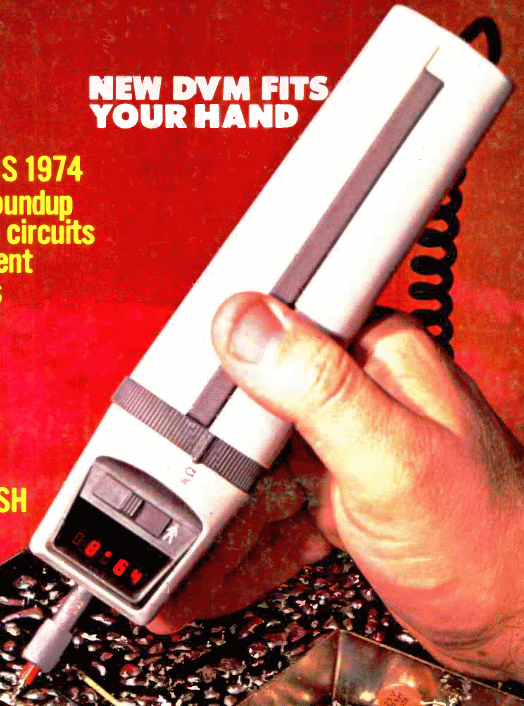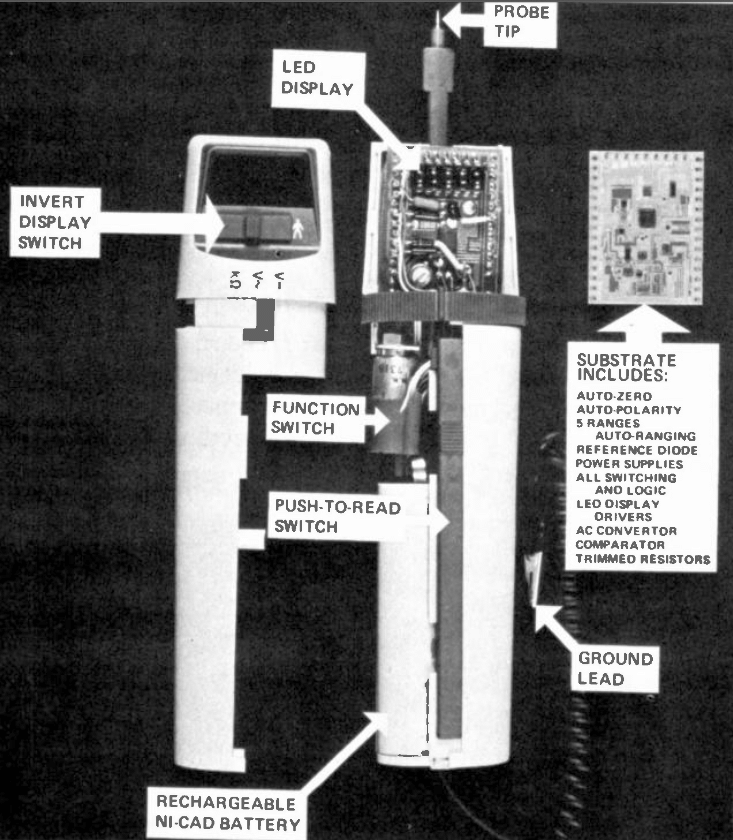 Seems that we just get accustomed to a new concept when someone
comes along and introduces still a newer concept. At least that's
the way it seems in the area of digital multi-meters which amateurs
have begun to accept and use. Just recently, however, Hewlett-Packard
broke the multi-meter market wide open by introducing their
Model 970A DMM, a palm-sized probe/meter tagged at a relatively
modest $275.
Seems that we just get accustomed to a new concept when someone
comes along and introduces still a newer concept. At least that's
the way it seems in the area of digital multi-meters which amateurs
have begun to accept and use. Just recently, however, Hewlett-Packard
broke the multi-meter market wide open by introducing their
Model 970A DMM, a palm-sized probe/meter tagged at a relatively
modest $275.
The Model 970A is an auto-ranging-type instrument measuring a.c. or d.c. volts, and ohms over five ranges. All electronics including the display and rechargeable battery pack are contained in a small, rugged hand-held package. Only one function control need be set, to select the parameter to be measured, and only two terminals are used for all functions.
HP uses a five-digit LED (Light Emitting Diode) cluster to provide a 3-1/2-digit DMM, so that all probe voltage readings are in volts, and resistance readings in kilohms. There are no scales to misinterpret. Decimal placement is automatic.
From an operational standpoint, automatic decimal placement and automatic polarity indication save time and increase accuracy. After setting the function selector (ac V, dc V or k&ohms;), the user simply touches the probe tip to the test point, presses a Push-to-Read bar, and the solid-state LED readout automatically displays the correct reading and polarity. When measuring ohms or d,c, volts it takes typically less than 2 seconds to range and settle to a proper reading.
Since the display is close to the point of measurement, a user working in closely-packed circuits can hold the probe in one hand without having to look away from the circuit to read the meter. The display can even be electronically inverted, so the operator needn't worry about reading 6's for 9's, or misplacing the decimal point if the probe is used upside down.
D.c. voltage from 0.1000 v. full scale to 500 v. is read to an accuracy of +/- (0.7% of reading + 0.2% of range). Full scale ranges are 0.1, 1, 10, 100, 1000 v. (500 v. maximum input).
A.c. voltages from 1 volt through the highest range, (500 volts r.m.s. maximum) from 45 Hz to 1 kHz, are read to +/- (2% of reading + 0.5% of range). Accuracy from 1 kHz to 3.5 kHz is +/- (3% of reading + 0.5% of range). On the 0.1 volt range and below, accuracy from 45 Hz to 1 kHz is +/- (2% of reading + 0.5% of range).
Resistance measurement accuracy is +/- (1.5% of reading +0.2% of range). Ohms rnages are 1 kilohm full scale (1 ohm resolution) through 10 megaohms. Maximum test current does not exceed 10 ma.
Nickel-cadmium rechargeable batteries and a battery charger come with the Model 970A. More than 2000 measurements can be made using the 'Press-to-Read' switch with a full charge. Batteries can be recharged in about 14 hours. The probe case is made of high-impact plastic with built-in stress reliefs to improve its resistance to an accidental drop. The probe is 6-1/2 inches long by 1-5/8 inches wide. The instrument weights 7 ounces.
For a full color brochure and more detailed information, circle A on the Reader Service Coupon on page 94.

